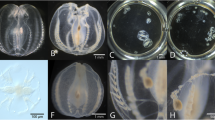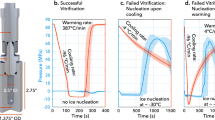Summary
The effect of increased temperature on the tissue integrity of polyps and medusae ofPodocoryne carnea is described. Animals exposed for 10 to 20 min to a temperature of 35°C are easily dissociated into single cells. These dissociated cells round up, form reaggregates and, depending on their origin, regenerate polyp or medusa structures. However, as the exposure time is increased, the dissociated cells gradually lose the ability to reaggregate or to regenerate defined structures. At incubation times exceeding 50 min, the tissue separates into single cells which retain their normalin vivo shapes but which do not form reaggregates. These are termed macerated cells. The ultrastructure and protein profile of macerated cells demonstrate no major changes from those of untreated cells. Both the dissociation and maceration methods are applicable to other cnidarian species for developmental, histological and biochemical studies.
Similar content being viewed by others
References
Bode H, Berking S, David CN, Gierer A, Schaller H, Trenkner E (1973) Quantitative analysis of cell types during growth and morphogenesis in hydra. Wilhelm Roux's Archives 171(4):269–285
Bonner WM, Laskey RA (1974) A film detection method for tritiumlabelled proteins and nucleic acids in polyacrylamide gels. Eur J Biochem 46:83–88
David CN (1973) A quatitative method for maceration of hydra tissue. Wilhelm Roux's Archives 171(4):259–268
Garrels JI (1979) Two-dimensional gel electrophoresis and computer analysis of proteins synthesized by clonal cell lines. J Biol Chem 254:7961–7977
Gierer A, Berking S, Bode H, David CN, Flick K, Hansmann G, Schaller H, Trenkner E (1972) Regeneration of Hydra from reaggregated cells. Nat New Biol 239(91):98–101
Laemmli UK (1970) Cleavage of structural proteins during the assembly of the head of bacteriophage T4. Nature (London) 227:680–685
Laskey RA, Mills AD (1975) Quantitative film detection of3H and14C in polyacrylamide gels by fluorography. Eur J Biochem 56:335–341
O'Farrell PH (1975) High resolution two-dimensional electrophoresis of proteins. J Biol Chem 250:4007–4021
Sato T (1967) A modified method for lead staining of thin sections. J Electronmicroscopy 16:133
Schmid V (1972) Untersuchungen über Dedifferenzierungsvorgänge bei Medusenknospen und Medusen vonPodocoryne carnea M. Sars. Wilhelm Roux's Archives 169:281–307
Schmid V (1979) The establishment of an in vitro regeneration system using anthomedusae. In: Experimentation sur des organismes marins élevés en laboratoire. Ann Soc Fr Biol Dev
Spurr AR (1969) A low-viscosity epoxy-resin embedding medium for electron microscopy. J Ultrastruct Res 26:31–43
Author information
Authors and Affiliations
Rights and permissions
About this article
Cite this article
Schmid, V., Stidwill, R., Bally, A. et al. Heat dissociation and maceration of marine Cnidaria. Wilhelm Roux' Archiv 190, 143–149 (1981). https://doi.org/10.1007/BF00867800
Received:
Accepted:
Issue Date:
DOI: https://doi.org/10.1007/BF00867800




